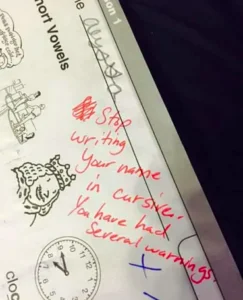In the digital age, where keyboards and screens have become the norm, the art of cursive writing is often overlooked in classrooms. However, a recent incident involving a young student named Alyssa has sparked an important discussion on the value of this timeless skill.
Alyssa, a seven-year-old student, received a homework assignment with a red-pencilled remark that read, “Stop writing your name in cursive. You’ve received multiple warnings.” This directive from her teacher has raised questions about the role of cursive writing in modern education.
While it may seem unfair to prevent a student from practicing a skill, it’s crucial to respect the decisions of teachers. They are the ones entrusted with the responsibility of guiding their students’ academic development. Even though cursive writing is not emphasized in every school, it remains a valuable asset that requires concentration and dedication to master.

Children who write in cursive often exhibit traits of focus and commitment that should be nurtured and encouraged in the classroom. These qualities are essential for academic success and personal growth, as they contribute to the development of cognitive skills and problem-solving abilities.
Cursive writing requires fine motor skills and hand-eye coordination, which can have a positive impact on a child’s overall dexterity and manual proficiency. This, in turn, can lead to improved handwriting, better note-taking, and enhanced fine motor skills that are valuable in various academic and professional settings.
Cursive writing can also serve as a outlet for self-expression and creativity. The fluid, connected nature of cursive allows students to develop their own unique writing styles, fostering a sense of personal identity and individuality.
Instructors who recognize the importance of cursive writing should approach it with a nurturing mindset. By giving their students encouragement and praise, they can foster a love of learning and a deeper appreciation for this timeless art form.
On the other hand, some educators argue that the time and resources dedicated to teaching cursive could be better spent on developing other essential skills, such as typing and digital literacy, which are more relevant in the modern workplace.
The debate over cursive writing in schools is not about whether it should be a mandatory requirement. It’s about recognizing the valuable lessons it can teach, and finding ways to inspire students to pursue it with enthusiasm and dedication, while also ensuring that they acquire the necessary skills for success in the digital age.

By embracing the art of cursive, we can unlock the potential of our young learners and set them on a path towards academic and personal success. Cursive writing is not just a skill to be mastered in the classroom; it can be a lifelong tool for self-expression, organization, and personal growth.
As technology continues to evolve, the role of cursive writing may need to adapt to the changing landscape. However, the core principles of focus, dedication, and self-expression that cursive fosters can still be valuable in the digital age, encouraging students to approach their work with mindfulness and attention to detail.
Rather than discouraging Alyssa’s efforts, her teacher could offer constructive criticism and encouragement. Providing positive feedback and guidance can help students like Alyssa develop their cursive writing skills, rather than simply dismissing their attempts.
The debate over cursive writing in schools is not about whether it should be a mandatory requirement. It’s about recognizing the valuable lessons it can teach, and finding ways to inspire students to pursue it with enthusiasm and dedication. By embracing the art of cursive, we can unlock the potential of our young learners and set them on a path towards academic and personal success.


